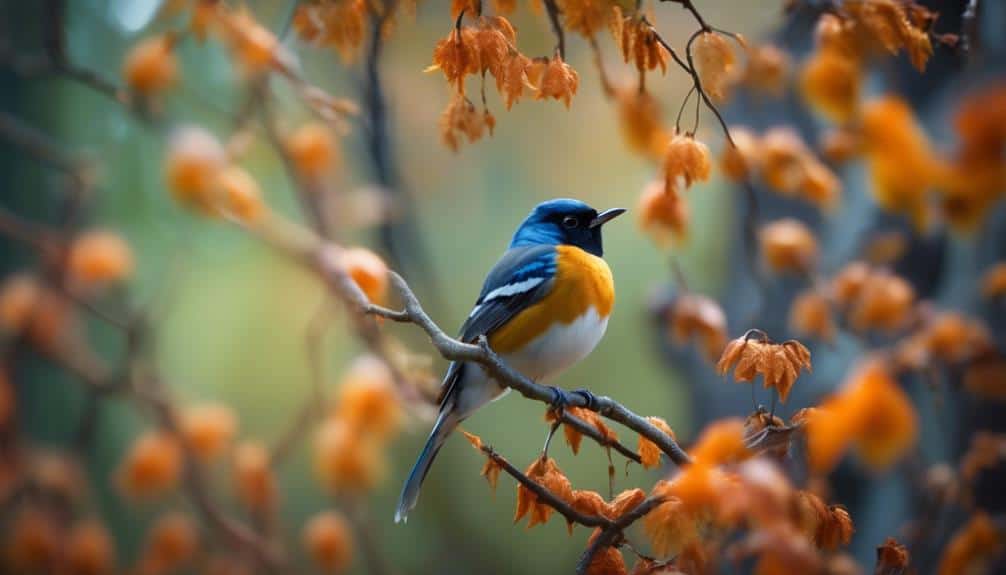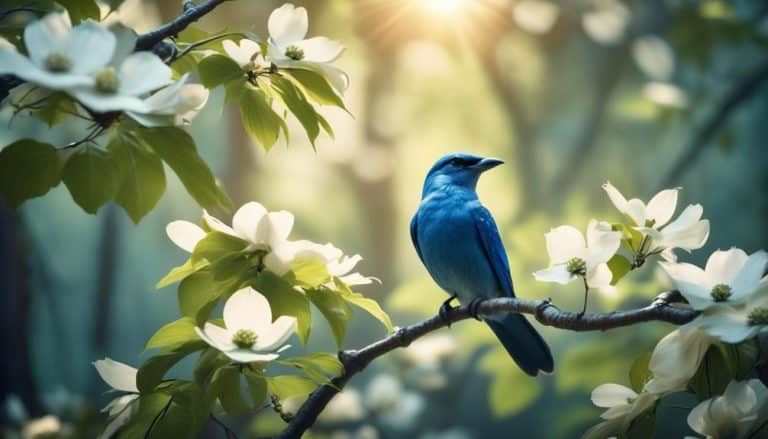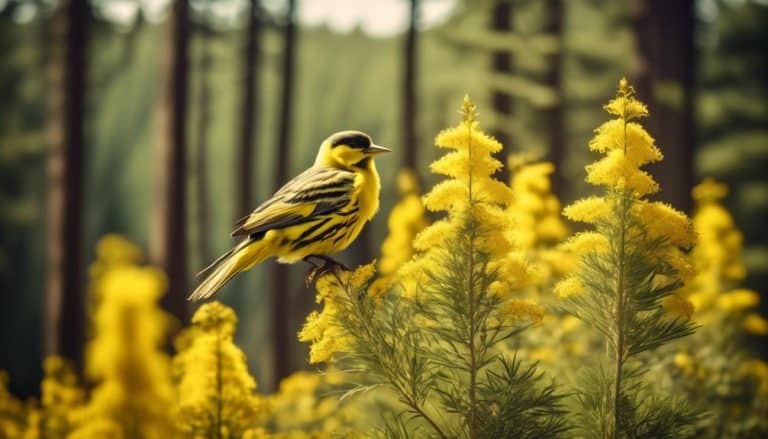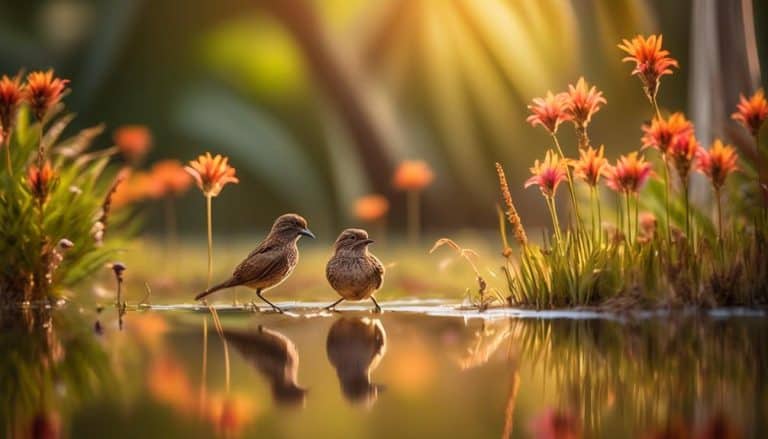As luck would have it, I found myself captivated by the enchanting melodies of songbirds during a recent hike in the picturesque woods of Michigan.
It was as if their harmonious tunes were beckoning me to uncover the beauty and diversity of these feathered creatures that grace our state.
From the vibrant colors of their plumage to their fascinating migration patterns, there is so much to discover about the songbirds of Michigan.
Join me as we embark on a journey to unravel their secrets and gain a deeper understanding of their vital role in our ecosystem.
Michigan's Native Songbird Species

Michigan is home to a diverse array of native songbird species. These birds exhibit fascinating mating behaviors, which have become the focus of songbird conservation efforts in the state.
One of the most well-known native songbirds in Michigan is the Eastern Bluebird (Sialia sialis). This species is known for its vibrant blue coloration and melodious song. During the mating season, male Eastern Bluebirds engage in courtship displays, where they flutter their wings and sing to attract potential mates.
Another native songbird species found in Michigan is the American Goldfinch (Spinus tristis). These birds undergo a unique molting process during the breeding season, where the males shed their dull winter plumage and acquire bright yellow feathers. This transformation is believed to play a role in attracting females.
The Black-capped Chickadee (Poecile atricapillus) is another native songbird species found in Michigan. These birds have complex vocalizations, including calls that are used for territorial defense and mate attraction.
The Colorful Plumage of Michigan's Songbirds
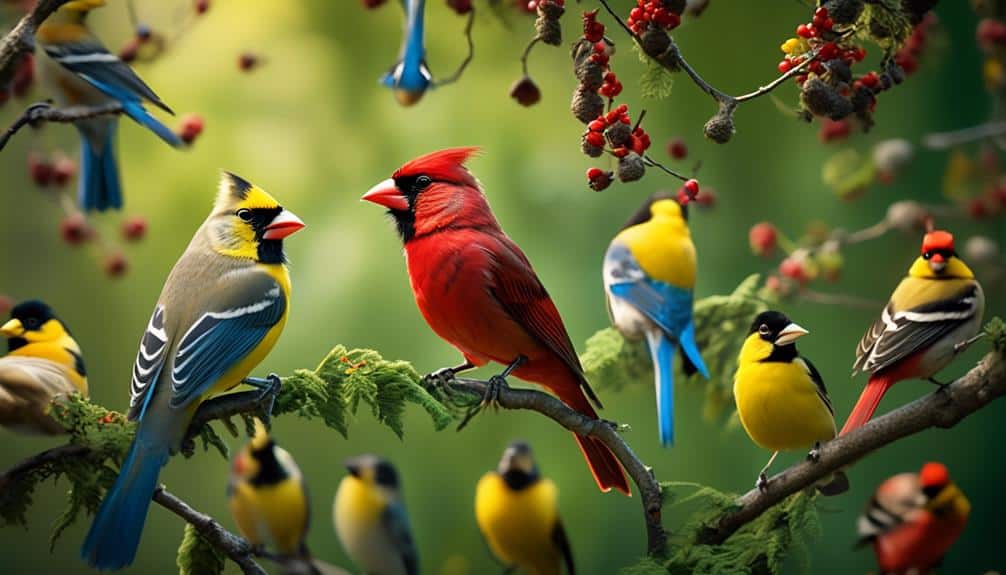
The vibrant plumage of Michigan's songbirds showcases a wide range of colors and patterns. These beautiful feathers not only serve to attract mates and repel rivals but also play a crucial role in species identification. Here are three examples of the stunning plumage found in Michigan's songbirds:
- The Eastern Bluebird (Sialia sialis): With its brilliant blue upperparts and rusty red breast, the Eastern Bluebird is a sight to behold. The males' vibrant colors are even more striking during the breeding season, attracting the attention of potential mates.
- The Baltimore Oriole (Icterus galbula): Known for its bright orange plumage, the Baltimore Oriole is a symbol of summer in Michigan. The males' orange and black feathers stand out against the green foliage, making them easily recognizable.
- The American Goldfinch (Spinus tristis): During the breeding season, male American Goldfinches display a stunning yellow plumage with contrasting black wings. This vibrant coloration helps them attract females, indicating their reproductive fitness.
Exploring birdwatching opportunities in Michigan allows enthusiasts to witness the beauty of these colorful songbirds firsthand. However, it's essential to remember the importance of bird conservation efforts. By preserving their natural habitats and supporting initiatives like bird banding and citizen science projects, we can ensure the continued existence of these mesmerizing creatures for future generations to enjoy.
Seasonal Migration Patterns of Songbirds in Michigan

Seasonal migration patterns of songbirds in the state of Michigan reveal the remarkable journeys these avian species undertake to navigate across vast distances and adapt to changing environmental conditions. The breeding habits of songbirds in Michigan play a crucial role in their migration patterns. These birds breed in Michigan during the summer months, taking advantage of the abundant food resources and favorable weather conditions. As the seasons change and resources become scarce, songbirds embark on long and arduous journeys to their wintering grounds in the southern United States, Mexico, Central America, and even South America.
During migration, songbirds face numerous threats that can impact their populations in Michigan. Habitat loss due to urbanization and deforestation disrupts their migration routes and reduces available stopover sites for rest and refueling. Climate change also poses a significant threat, as it alters the timing of migration and disrupts the availability of food resources along the migration routes. Additionally, collisions with buildings and communication towers are a significant cause of mortality for migrating songbirds.
To mitigate these threats and protect songbird populations in Michigan, conservation efforts are essential. Preserving and restoring habitat along the migration routes, including breeding and wintering grounds, is crucial. Implementing bird-friendly building designs and reducing light pollution can help minimize collisions. Furthermore, advocating for policies that address climate change and promote sustainable land use practices is vital for the long-term survival of these remarkable migratory songbirds.
Habitat Preferences of Michigan's Songbird Species

Numerous songbird species in Michigan demonstrate specific habitat preferences that contribute to their survival and reproductive success. Understanding these preferences is essential for birdwatchers and conservation efforts.
Here are three key habitat preferences of Michigan's songbird species:
- Forested Areas: Many songbirds in Michigan prefer nesting and foraging in forested areas. These habitats provide a diverse range of food sources, shelter, and nesting sites. Tree-dwelling species like warblers and thrushes thrive in the dense canopy cover and understory vegetation found in forests. Birdwatchers can explore state parks and nature reserves with well-preserved forests to observe these species in their natural habitats.
- Wetlands: Wetlands are crucial habitats for songbirds, as they provide abundant food resources and nesting sites. Species like red-winged blackbirds and marsh wrens thrive in the dense vegetation and shallow water found in wetlands. Birdwatchers can visit wetland areas such as marshes, swamps, and bogs to observe these vibrant and melodious birds.
- Open Fields and Grasslands: Some songbirds prefer open fields and grasslands for nesting and foraging. These habitats provide ample opportunities for ground-nesting species like meadowlarks and sparrows. Birdwatchers can explore agricultural fields, prairies, and grasslands to spot these species and enjoy their beautiful songs.
The Role of Songbirds in Michigan's Ecosystem

Songbirds play a vital role in Michigan's ecosystem by contributing to seed dispersal, insect control, and plant pollination. These small, colorful birds are crucial for maintaining the balance and health of the state's natural environment. Without them, there would be significant consequences for Michigan's biodiversity and overall ecosystem resilience.
One of the key contributions of songbirds is seed dispersal. As they consume fruits and berries, they inadvertently transport seeds to different locations, aiding in the natural regeneration of plant species. This process helps maintain genetic diversity within plant populations and promotes the establishment of new habitats.
In addition to seed dispersal, songbirds also play a crucial role in insect control. Many species of songbirds feed on insects, including harmful pests that can damage crops and vegetation. By reducing the populations of these pests, songbirds contribute to the overall health of Michigan's forests, fields, and gardens.
Furthermore, songbirds are important pollinators. As they move from flower to flower in search of nectar, they transfer pollen, enabling the fertilization and reproduction of plants. This process is essential for the production of fruits, seeds, and the maintenance of plant diversity.
Table: The Role of Songbirds in Michigan's Ecosystem
| Contribution | Importance |
|---|---|
| Seed dispersal | Genetic diversity |
| Insect control | Pest population |
| Plant pollination | Reproduction |
Given the significance of songbirds in Michigan's ecosystem, it is crucial to prioritize their conservation. Unfortunately, climate change poses a threat to songbird populations. Rising temperatures, changing weather patterns, and habitat loss can disrupt their breeding and migration patterns, leading to population declines. To preserve these vital ecosystem contributors, it is essential to mitigate the impact of climate change and protect their habitats through conservation efforts. By doing so, we can ensure the continued functioning and resilience of Michigan's natural ecosystems.
Frequently Asked Questions
How Can I Attract Songbirds to My Backyard in Michigan?
I attract songbirds to my backyard in Michigan by setting up bird feeders. The feeders provide a constant source of food, attracting various species of songbirds.
Are There Any Endangered Songbird Species in Michigan?
Yes, there are endangered songbird species in Michigan. Conservation efforts for these birds aim to protect their habitats, reduce threats such as habitat loss and fragmentation, and promote sustainable practices to ensure their survival.
Do Songbirds in Michigan Sing Different Songs Depending on the Season?
Yes, songbirds in Michigan can learn different songs depending on the season. Seasonal variations in songbird songs are a common occurrence, as they adjust their vocalizations to attract mates, establish territory, and communicate with other birds.
What Threats Do Songbirds Face in Michigan and How Can We Help Protect Them?
Threats to songbirds in Michigan include habitat loss, climate change, and predation. Conservation efforts focus on creating protected areas, restoring habitats, and promoting bird-friendly practices. Birdwatching opportunities abound in Michigan, providing a chance to appreciate and support these beautiful creatures.
Are There Any Specific Plants or Trees That Songbirds in Michigan Prefer to Nest In?
Do Michigan songbirds have specific preferences for nesting plants and trees? It is crucial to understand their needs to attract them to our backyards. Additionally, protecting these preferred habitats can help safeguard endangered songbird species and their beautiful songs.
Conclusion
In conclusion, Michigan's native songbird species play a crucial role in the state's ecosystem.
Their vibrant plumage adds a splash of color to the natural landscape, while their seasonal migration patterns allow for a dynamic and diverse environment.
These songbirds are highly adaptable and can be found in various habitats throughout Michigan.
Like a symphony of melodies, they contribute to the intricate balance of nature, reminding us of the interconnectedness of all living beings.

